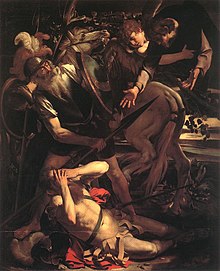| Revision as of 21:06, 25 April 2012 editStAnselm (talk | contribs)Autopatrolled, Extended confirmed users, File movers, New page reviewers, Pending changes reviewers160,759 edits →Claimed examples of Christophanies in the Hebrew Bible: added wikilink, removed misleading date← Previous edit | Revision as of 21:07, 25 April 2012 edit undoStAnselm (talk | contribs)Autopatrolled, Extended confirmed users, File movers, New page reviewers, Pending changes reviewers160,759 edits added Category:Theophany using HotCatNext edit → | ||
| Line 63: | Line 63: | ||
| ] | ] | ||
| ] | ] | ||
| ] | |||
| ] | ] | ||
Revision as of 21:07, 25 April 2012
A Christophany is an appearance, or non-physical manifestation, of Christ.
Traditionally the term refers to visions of Christ after his ascension such as the bright light of the Damascus Christophany.
Also, following the example of Justin Martyr who identified the Angel of the Lord with the Logos some appearances of angels in the Hebrew Bible are also identified by some Evangelicals as preincarnate appearances of Christ, using the term "Christophanies" - by comparison with Theophanies - appearances of God.
Use of the term
The etymology is from the Greek noun Christos- "Christ, Anointed", and the Greek ending "phany" from the verb phaneroō, to be revealed or to manifest. This noun is derived by direct comparison with the term theophany (theo-phaneia).
- Academics generally use the term solely in relation to the documented New Testament visions of Christ.
- George Balderston Kidd (1852) popularised the term in relation to the identification of angels in the Old Testament as Christ.
- Since the work of James Borland (1978) usage of the term in conservative Christian publications related to Old Testament appearances of Christ has multiplied exponentially.
- The term was used by Albert Joseph Edmunds (1857–1941) in relation to the revealing of Christ in Christianity and Buddhism.
New Testament

- A New Testament Christophany is Paul's vision of Christ on the road to Damascus, and the subsequent one of Ananias.
- Another New Testament example is the vision of St. John the Divine, recounted in Revelation 1:12-18.
Claimed examples of Christophanies in the Hebrew Bible
Some Christian commentators have seen appearances by the pre-existent Christ in the Hebrew Bible:
- Jonathan Edwards identified an example in Daniel 3:25, when the fourth man in the furnace is described as "like a son of the gods."
Visions of Christ after the New Testament
Main article: Visions of Jesus and MaryA vision is not usually described as a Christophany.
- Saint Jerome is believed to have had a precise vision of the Blessed Trinity, as is illustrated by Andrea del Castagno.
- Magdalena de Pazzi was a deep mystic who claimed several christophanies about the Trinity.
- Lúcia dos Santos of Fatima claimed to have seen Jesus in the Trinity in Tuy in 1926.
- Mary Faustina Kowalska claimed to have had recorded her visions of Jesus.
- According to the Book of Mormon, Jesus Christ appeared to a group of people living in the Americas.
References
- Carey C. Newman Paul's glory-christology: tradition and rhetoric p164 1992 "The thesis defended below can be simply stated: the Damascus Christophany is the interpretive "origin" of Paul's ... That is, the vision of the resurrected and exalted Jesus, the Christophany, was the catalyst for the apostle's ...
- in The new Schaff-Herzog encyclopedia of religious knowledge: vol 11,1912 "the practise of the Greek Fathers from Justin Martyr, who identified the "angel of the Lord " with the Logos, furnish excuse for conceiving also the theophanies of the Old Testament as christophanies. "
- Ron Rhodes What Does the Bible Say About...?, 2007, p.125 "I believe that theophanies in the Old Testament were actually preincarnate appearances of Christ. The principal theophany of the Old Testament is the Angel of the Lord (or, more literally, Angel of Yahweh)"
- Christophany - The doctrine of the manifestations of the Son of God under the economy of the Old Testament 1852. Note, though, that the title was added postumously, and the only use of the word in the book itself is a citation of another scholar.
- James A. Borland, Christ in the Old Testament: Old Testament Appearances of Christ in Human Form, Chicago: Moody, 1978; 2nd ed. Fearn: Mentor, 1999; fresh reprint 2010. Borland's original doctoral work carried the main title Christophanies (ThD diss.; Grace Theological Seminary, 1976).
- Albert Joseph Edmunds, Masaharieed Anesaki Buddhist and Christian Gospels 1900? 2009 reprint Page 101 "CHRISTOPHANY: HE WHO SEES THE TRUTH SEES THE LORD. John XIV. 6; 9; 18-21."
- The works of Jonathan Edwards 1835 p564 "And the prophet Daniel, in the historical part of his book, gives an account of a very remarkable appearance of Christ in Nebuchadnezzar's furnace, with Shadrach, Meshach, and Abednego."